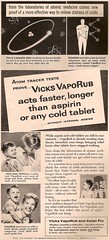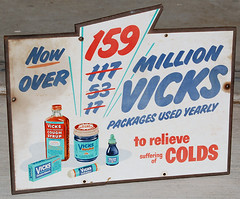Lunsford Richardson II
Inventor of Vicks VapoRub
by Lindsey Hinds-Brown
Reprinted with permission from the Tar Heel Junior Historian, Fall 2006; Revised October, 2022. Tar Heel Junior Historian Association, NC Museum of History
Tar Heel Junior Historian Association, NC Museum of History
See also: Vick Chemical Company
Lunsford Richardson II was born on Parker Heights Plantation in Johnston County on December 29, 1854. The youngest of five children, he witnessed much suffering during his childhood. Richardson was only two years old when his father died in a flood. At age ten, he watched as the Union Army—led by General William Tecumseh Sherman— raided his home during the Civil War. The soldiers seized all his family’s food and belongings, leaving behind only a few hams that he and his mother had hidden in the hollow columns of their house. After the Emancipation Proclamation freed their owned enslaved people, Richardson helped his mother adjust to a new way of farming and life.
Richardson knew he wanted to help others and needed a college education to achieve his goals. Unable to afford a full four years of college, he studied hard and completed his degree in only three years. He graduated from Davidson College in 1875 with a major in chemistry and honors’ medals in Greek, Latin, and debate. The young graduate wanted to become a lawyer but had no money to start a law practice. Reluctantly, Richardson accepted a teaching position at a local school. He quit after five years. With only $600 in savings, he wanted a fresh start and a career that combined his interests in chemistry and Latin.
While visiting his sister near Selma in 1880, Richardson bought a small drugstore for $450. He used his knowledge of Latin to understand the names on the bottles of medicine and researched the drugs to find out which ones would best treat his customers’ symptoms. His dedication and hard work helped people in Selma feel better and helped him save enough money to marry and start a family.
After ten years in Selma, Richardson wanted to expand his business. He moved his family to Greensboro in 1890 and, with the help of his partner J. B. Fariss, bought the W. C. Porter Drug Store. Years later the building became famous for the two extraordinary men who had once worked there: Richardson himself and Mr. Porter’s nephew, William Sidney Porter—the celebrated short-story writer known as O. Henry. Richardson changed the way drugstores operated in Greensboro. Before he took over, customers usually charged purchases to a store account and paid on the balance once or twice a year. His new policy required that customers pay their bills in full every month. This plan prevented farmers from building up large debts and guaranteed that storeowners got paid for what they sold. Soon all drugstores in the area followed his example.
Still, Richardson’s greatest contribution to pharmacy was not his economic practicality but the medicines he invented. Customers trusted him, and they often asked him for medical advice when they could not afford to visit a doctor. Richardson saw the need for affordable treatments that worked. He began experimenting with new ingredients and invented twenty-one medicines he called Vicks Family Remedies.
Why Richardson chose the name Vicks for his products is something of a mystery. Some sources state that he simply named them in honor of his brother-in-law, and others insist he ran across the name in a popular seed catalog. Richardson once claimed the main reason for the Vicks name was that it was short enough to fit on small medicine bottle labels.
Vicks Family Remedies became so popular that in 1898 Richardson sold his half of the drugstore to his former partner and started his own company. The L. Richardson Drug Company was a wholesale drug business that sold medicines to drugstores throughout the state. It also manufactured Vicks products. The top seller was a revolutionary external treatment for coughs and colds called Vicks Magic Croup and Pneumonia Salve.
Richardson first created this salve to treat his son’s frequent bouts of “croup,” a respiratory illness that made it hard for children to breathe. At the time, most treatments for croup required swallowing a pill or drinking a potion. Some of the medicines had serious side effects that made people sicker than the original illness! But Vicks Salve was different. Richardson made an ointment using a new ingredient from Japan called menthol, which turned into vapor when heated. He combined menthol with the ingredients found in most cough and cold medications. When a patient rubbed Vicks Salve on his or her chest, body heat activated the menthol, and the patient breathed the medicated vapors directly into the lungs. This “magic” treatment eased patients’ discomfort, and, best of all, there were no pills or potions.
Although Vicks Salve began as a simple home remedy, it soon became a household name. Richardson first made and packaged the medicine—in its unique, little blue bottle—by hand in a small Greensboro factory. But demand grew quickly, as salesmen traveled throughout North Carolina nailing some of the South’s first billboards to trees and barns.
The widespread popularity of Vicks Salve brought many changes to Richardson’s life. To make enough medicine, he made his factory larger and mechanized the manufacturing and packaging process. In 1905 he closed his wholesale drug company and created Vick Chemical Company to concentrate on his own products. His son, Henry Smith Richardson, joined the business in 1907 and convinced his father to make only Vicks Salve. The product’s name was changed to Vicks VapoRub, not only to describe how the medicine worked but to stand out among numerous competitors.
Toward the end of Richardson’s life, Vicks VapoRub became the leading treatment for coughs and colds throughout the United States. There was a great flu epidemic in 1918, and employees worked endlessly to meet customer demand. By 1919 VapoRub was sold in every state. In a speech given to the North Carolina Pharmaceutical Association a few months prior to his death, Richardson said, “I had seen a vision, I had dreamed dreams of a worldwide business.”
Richardson passed away in August 1919, but his legacy and vision live on. In the years after his death, a missionary school, a local hospital for African Americans, and a World War II Liberty ship were named in his memory. In 1935 his children established the Richardson Foundation to promote scientific and charitable projects. Today Procter and Gamble Company produces VapoRub and an extended line of Vicks products. Nearly ninety years after Richardson’s death, his “magic” salve continues to relieve the discomfort of sick people throughout the world.
At the time of this article’s publication, Lindsey Hinds-Brown, a former middle school social studies teacher, was a Ph.D. student in American history at the University of North Carolina at Greensboro. She also worked as a freelance researcher for the Greensboro Historical Museum.
Additional Resources:
North Carolina Museum of History: http://www.ncmuseumofhistory.org/collateral/articles/L.Richardson.pdf
GreensboroHistory.Org http://www.greensborohistory.org/archives/mss/html/MssColl-055--Richards...
NCMarkers: https://www.ncdcr.gov/about/history/division-historical-resources/nc-hig...
North Carolina History Project: http://www.northcarolinahistory.org/encyclopedia/444/entry
Vicks Company Timeline: http://www.vicks.com/about/timeline/
Image Credits:
P, Liza. Photo taken July 17, 2008. "Feb58womansday-vicks//1950s Ads." Located at https://www.flickr.com/photos/lobstar/2681349433/. Accessed March 6, 2012.
Boxley, Paul. Photo taken July 16, 2007. "Vick [Vintage]." Located at https://www.flickr.com/photos/paulboxley/1216223882/. Accessed March 6, 2012.
Photo taken November 10, 2006. "Vicks Medicine Sign, 1950's." Located at https://www.flickr.com/photos/roadsidepictures/1952207187/. Accessed March 6, 2012.
1 January 2006 | Hinds-Brown, Lindsey
![Boxley, Paul. Photo taken July 16, 2007. "Vick [Vintage]." Vick](http://farm2.staticflickr.com/1133/1216223882_afde1e3d02_m.jpg)